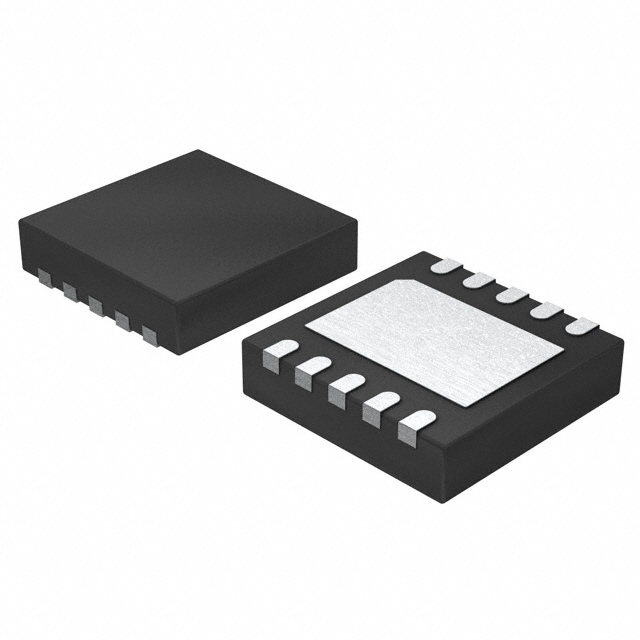LTC3407AIDD-2#PBF
Product Overview
The LTC3407AIDD-2#PBF belongs to the category of high-efficiency, low quiescent current synchronous buck regulators. It is commonly used in various electronic devices and systems to efficiently regulate voltage levels. The LTC3407AIDD-2#PBF is known for its compact package, high efficiency, and low quiescent current, making it suitable for battery-powered applications. It is available in a 8-Lead, 3mm x 3mm DFN package and is designed to provide essential power management capabilities in a small form factor.
Basic Information
- Category: Voltage Regulator
- Use: Efficient regulation of voltage levels
- Characteristics: High efficiency, low quiescent current
- Package: 8-Lead, 3mm x 3mm DFN
- Essence: Compact and efficient power management
- Packaging/Quantity: Available in tape and reel packaging, quantity varies based on supplier
Specifications
The LTC3407AIDD-2#PBF features a wide input voltage range of 2.5V to 5.5V and can deliver an output current of up to 800mA. It operates at a high switching frequency of up to 2.25MHz, allowing for the use of small external components. The regulator also offers a low quiescent current of only 22μA, contributing to its overall efficiency.
Detailed Pin Configuration
The LTC3407AIDD-2#PBF has a total of 8 pins, each serving specific functions: 1. VIN - Input Voltage 2. SW - Switch Node 3. GND - Ground 4. FB - Feedback 5. EN - Enable 6. PG - Power Good 7. SS - Soft-Start 8. VOUT - Output Voltage
Functional Features
- Wide input voltage range
- High efficiency
- Low quiescent current
- Internal synchronous rectification
- Overcurrent and overtemperature protection
Advantages and Disadvantages
Advantages
- Small form factor
- High efficiency
- Wide input voltage range
- Low quiescent current
- Integrated protection features
Disadvantages
- Limited maximum output current
- Sensitive to external noise due to high switching frequency
Working Principles
The LTC3407AIDD-2#PBF operates on the principle of synchronous buck regulation, where the input voltage is efficiently reduced to a lower, regulated output voltage. This is achieved through high-frequency switching of the internal MOSFETs, minimizing power loss and maximizing efficiency.
Detailed Application Field Plans
The LTC3407AIDD-2#PBF finds extensive application in battery-powered devices such as portable electronics, IoT devices, and handheld instruments. Its compact size and high efficiency make it ideal for space-constrained applications where power management is critical.
Detailed and Complete Alternative Models
- LTC3407BIDD-2#PBF: Similar specifications with enhanced thermal performance
- LTC3407CIDD-2#PBF: Higher output current capability with slightly larger package size
- LTC3112EUD-5#PBF: Buck-boost regulator with wider input voltage range
In conclusion, the LTC3407AIDD-2#PBF is a versatile and efficient voltage regulator suitable for a wide range of battery-powered applications. Its compact design, high efficiency, and integrated protection features make it a popular choice for designers seeking reliable power management solutions.
Word Count: 515
Senaraikan 10 soalan dan jawapan biasa yang berkaitan dengan aplikasi LTC3407AIDD-2#PBF dalam penyelesaian teknikal
What is the input voltage range of LTC3407AIDD-2#PBF?
- The input voltage range of LTC3407AIDD-2#PBF is 2.5V to 5.5V.
What is the output voltage range of LTC3407AIDD-2#PBF?
- The output voltage range of LTC3407AIDD-2#PBF is adjustable from 0.6V to VIN.
What is the maximum output current of LTC3407AIDD-2#PBF?
- The maximum output current of LTC3407AIDD-2#PBF is 800mA.
What is the typical efficiency of LTC3407AIDD-2#PBF?
- The typical efficiency of LTC3407AIDD-2#PBF is around 95%.
What are the key features of LTC3407AIDD-2#PBF?
- The key features of LTC3407AIDD-2#PBF include low quiescent current, high efficiency, and a wide input voltage range.
Can LTC3407AIDD-2#PBF be used in battery-powered applications?
- Yes, LTC3407AIDD-2#PBF is suitable for battery-powered applications due to its low quiescent current and high efficiency.
What type of protection does LTC3407AIDD-2#PBF offer?
- LTC3407AIDD-2#PBF offers overcurrent protection and thermal shutdown to safeguard the system.
Is LTC3407AIDD-2#PBF suitable for space-constrained designs?
- Yes, LTC3407AIDD-2#PBF comes in a compact package and is suitable for space-constrained designs.
What are the typical applications of LTC3407AIDD-2#PBF?
- Typical applications of LTC3407AIDD-2#PBF include portable devices, IoT devices, and battery-powered systems.
Does LTC3407AIDD-2#PBF require external compensation components?
- No, LTC3407AIDD-2#PBF has internal compensation, reducing the need for external components.


